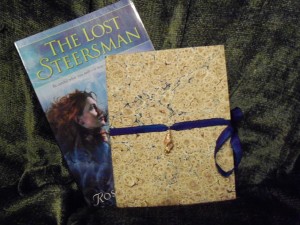Pulled out of internet limbo
An acquaintance sent me an email, asking about the source of inspiration for certain aspects of the Demons in The Lost Steersman. I thought to myself: Hey, I can just direct him to the article I wrote on that very subject, on my publisher’s website! Easy.
Except, on examination, the Del Rey Books site has undergone several redesigns since then, and the article is – gasp! – no longer to be found there!
Ah, but I now have my own website (well, blog, but expansions are being planned). I can just repost it here.
And so I shall:
Sea, Sky
by Rosemary KirsteinOne day, when I was a little girl, I was walking along a crowded, grubby beach when I came across a curious object: two-thirds of a flattened circle, made of what seemed to be pale gray rubber and sand. I remember strolling along turning it over and over in my hands trying to fit it into my young picture of the world.
I brought it to my parents where they lounged on the old blanket next to the ice-chest, amid neighboring families’ dueling transistor radios. My father’s reaction was a shrug, and a dismissive “Trash,” but my mother’s was “Garbage” — quite a different matter: dirty, probably rotten, and certainly chock-full of germs. She made me throw it away.
But it was very weird. I remember how very, very weird it was.
Some time later, I was paging through books in my town’s little library. I had run through the astronomy books and out of desperation started on biology, because it was science. I knew I loved astronomy, and astronomy was “science,” so maybe other sciences would be just as good. Also, I figured it was about animals. I liked animals.
And there, in a book about sea-life, I found my mysterious object. It was a “sand collar” — the egg-case laid by moon snails. I loved that name: moon snail.
 image by Nick Hobgood, creative commons
image by Nick Hobgood, creative commons
Fast-forward a number of years, and I am wandering around the exhibits of the Air and Space Museum. This was back when it temporarily shared space with the Smithsonian, and many of its displays were just stuffed wherever they would fit. I was circumnavigating the corridor outside the planetarium, coming across object after fascinating object every few feet. And among them, casually sitting on a cheapo plastic pedestal:
Telstar.
The communications satellite. Not a mockup of the one they sent up; a second actual satellite that for some reason was never launched. And in that cramped, ill-lit corridor, one thing struck me above all else, coming as a blow to the heart, sudden, hard and deep, and it was this:
It was beautiful.
Beyond my love of science, and of technology, the object was simply beautiful. Faceted, faced with many small glittering purple gems (solar cells). And I thought: That’s what we made. That’s what we put in the sky. It’s up there now. A jewel, hanging above the earth.
Forward a few more years — okay, many years — and I am creating…. a world.
How do you create a world?
There are basically two ways to do it. You can begin from the top down, or from the ground up.
Beginning from the top down, you set up your situation, and with that as given, trace down to the root, to the causes. From what is, you work out how it must have happened; and from that, where it might go from here.
Beginning from the bottom up, you take facts — hard science if you’ve got it, soft science if you don’t — twist them a bit, wind them up and let them go. See how it plays out. And from that, discover how the world of your story must be now.
Pick one method, or the other. Or you can do what I did: use both.
Beginning from the top down: a geostationary satellite above a world where the bulk of humanity has no science, and only simple technology. What would they think of it? And what would it mean, that it could even be there, hanging above a low-tech society?
And beginning from the bottom up: a rubbery, sandy object, an egg-case laid by a creature descended from sea-creatures. Because of its reproductive nature, this creature has an instinctive ability to make objects. And, coming from the sea, it perceives by reflected sound. So, it might not use its voice to speak — but if it were intelligent, how would it communicate? What’s available?
These are not the only points of inspiration I used in creating Rowan’s world in the Steerswoman Series. But the moon-snail egg case was surely the first, and Telstar surely the most striking.
And one last useful thing — not in creating the world, but creating the story taking place in the world. It comes from songwriter Hoyt Axton, who said: “Always write the last line first. Then you know where you’re heading.”
I know the last line of the last book in the Steerswoman Series.
But I’m not telling.
copyright 2004, Rosemary Kirstein / creative commons 2012
errata:
On research not available to me at the time I wrote the article, it turns out that the satellite was certainly not Telstar, but was probably Intelsat I, aka Early Bird.
There’s a much nicer, non-public domain photo to be found here.
Also, the sand collar of the moon snail has eggs imbedded within the gum of the collar itself; demons, on the other hand, use the gum-and-sand to create a casing that encloses the central mass of eggs.

